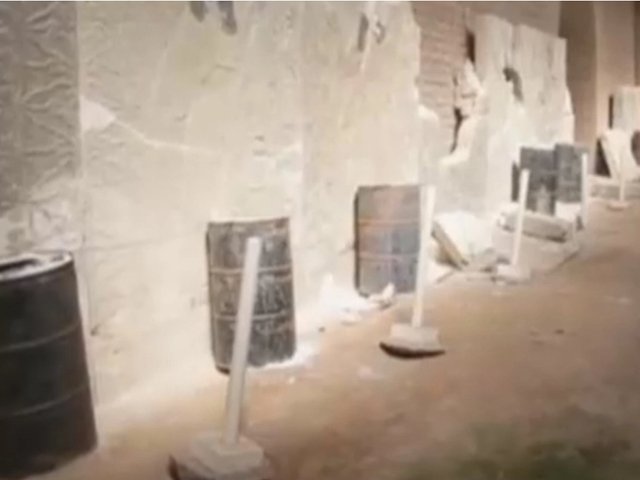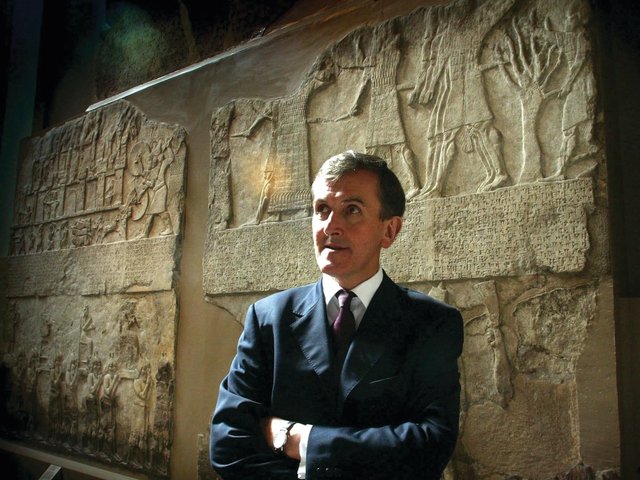A detailed account of the discovery of the Nimrud gold, a spectacular cache of ancient Assyrian royal jewellery found in Iraq in 1989, was to have been presented at a conference at the British Museum last November, but the event was postponed by the museum because of the difficulty in obtaining UK entry visas for the Iraqi archaeologists scheduled to attend.
The ancient Nimrud gold was found by Iraqi archaeologists in 1989 just before the Gulf War. Soon afterwards the golden jewellery was moved to a Baghdad bank vault to protect it against American bombing raids. “The Nimrud treasure ranks alongside that of Tutankhamen,” according to British Museum keeper Dr John Curtis, one of the few Western specialists to have seen the cache which was made in Assyria in the eighth century BC. On viewing it in Baghdad, he was absolutely astonished by both its quality and quantity. He describes the Nimrud trove, as “the finest jewellery of this date from anywhere in the ancient world.”
Although the find took place over a decade ago, few details about the Nimrud treasure have emerged, little information has been published, and the hoard’s full importance has not yet been appreciated.
In 1950 British Museum archaeologist Max Mallowan (who was married to Agatha Christie) was excavating in the north-west Palace of Nimrud, near Mosul in northern Iraq. He cleared a room in the harem, but seems to have failed to notice that the pattern of the floor tiles had at some point been altered slightly. It was not until 1989 that the disturbed tiles were spotted by Iraqi archaeologist Muzahim Mahmud, who thought there might be something beneath.
Mr Mahmud dug, and discovered the burial tombs of the Assyrian queens. There he encountered a stone tablet, inscribed with a curse, which warned that anyone who “lays hands on my jewellery with evil intent, or whoever breaks open the seal of this tomb, let his spirit wander in thirst.”
Due to the unsettled political situation, the contents of the royal tombs were very briefly put on public display in the Iraq Museum, where the material was seen by only a very few Western scholars, including Dr Curtis. Following the invasion of Kuwait in 1990, the Nimrud jewels were removed to a government bank vault where they remain. The only scholarly account of the find is a short study by Dr Muayyad Sa’id Damerji and Ahmed Kamil, which was published two years ago by the Iraqi Department of Antiquities and Heritage in a specialist German monograph, Gräber Assyrischer Königinnen aus Nimrud. It records that two skeletons were found in the tomb and gives the first detailed transcriptions which identify them. The two queens were Yaba (wife of King Tiglatpileser III, who died 727 BC) and Atalia (wife of King Sargon II, who died 705 BC).
Cambridge University specialist Joan Oates has recorded summary details of the contents of the tomb of the two queens in a book on Nimrud to be published by the British School of Archaeology in Iraq, which is in temporary exile in London. She lists the treasure: a gold crown, a gold mesh diadem with a tasselled gold fringe and tiger-eye agate rosettes, 79 gold earrings, six gold necklaces, 30 finger rings, 14 armlets, four gold anklets (two weighing a kilo each), 90 necklaces with semiprecious stones, 15 gold vessels and a group of rock crystal vessels. The total weight of the gold from this single tomb is 14 kilos, much of it probably ancient war loot.
The Iraqi experts invited to London (Manhal Jabbar, Dr Donny George, Dr Muayyad Sa’id Damerji, Dr Ali Yaseen Ahmad, Muzahim Mahmud, Dr Rabi’a Mahmood Al-Qaissi and Dr Jabar Ibrahim) are set to attend the Nimrud conference at the British Museum 11-13 March provided UK visas are issued in time. For information: Tel: +44 (0) 20 7323 8657.
Originally appeared in The Art Newspaper as 'The hidden treasure'



